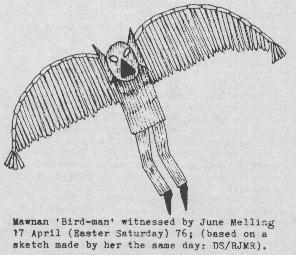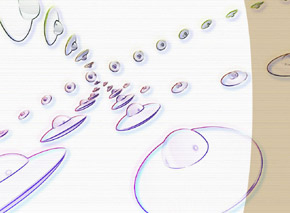-
SNAKES ALIVE DEPARTMENT -
The Unnatural History of
Winged Snakes in North America

Even in today’s decidedly cynical and rational culture, legends and
alleged sightings of exceptional and mysterious creatures are still—on
occasion—featured in the news media, and dominate the 100-realm of our
libraries’ Dewey decimal classification section. In the modern age, the
“big three” cryptozoologically dominate: Sasquatch, lake monsters and
the Chupacabra. Rewind the clock back 125 years though and a new “top
three list” of whispered-about mystery creatures emerges from North
America: “Wild men of the woods” (likely an early nomenclature for what
will later come to be known as Bigfoot), sea serpents and…Winged Snakes
If one were to design the simplest animal that would generate the
greatest commotion among the public at large, the winged snake might be
the ideal conception. Coalescing the most ominous features of two of
the most traditionally feared critters—the snake and the bat, the idea
of the existence of winged snakes was, historically, a nineteenth
century hullabaloo just waiting to happen.
The idea of a serpent that can fly is by no means a contemporary
concept. The classic Chinese dragons, though wingless, were built upon
this notion. The belief peaked perhaps in ancient Egypt, where numerous
examples of winged snakes can be found depicted in tomes of all types
from the region. These were, ostensibly, not merely for dramatic
graphic illustration. The prominent historian Herodotus wrote about
these animals as actual biological components within the Egyptian
ecology. Consider the following passage from his History of Egypt, Book
2. Chapter LXXV:
I went to a certain place in Arabia, almost exactly opposite the city
of Buto, to make inquiries concerning the winged serpents. On my
arrival I saw the back-bones and ribs of serpents in such numbers as it
is impossible to describe; of the ribs there were a multitude of heaps,
some great, some small, some middle-sized. The place where the bones
lie is at the entrance of a narrow gorge between the steep mountains,
which there open upon a spacious plain communicating with the great
plains of Egypt. The story goes, that the spring the snakes come flying
from Arabia towards Egypt, but are met in this gorge by the birds
called ibises, who forbid their entrance and destroy them all. The
Arabians assert, and the Egyptians also admit, that it is on account of
the service thus rendered that the Egyptians hold the ibis in so much
reverence.
While many historians dismiss this passage as a misguided connection to
swarms of locusts, it is problematic to reconcile this explanation with
Herodotus’s reference to having been witness to their “bones” and
“ribs”. Similarly damning is the fact that Herodotus described their
wings as bat-like rather than feathered as a bird. Others reject the
account as a mere fable to explicate the Egyptians’ reverence for the
ibis.
The Bible too mentions these creatures in Isaiah 30:6 and refers to
them as “saraph”, often translated as the “fiery flying
serpents”. The “fire” here referring to their poison’s burning
sensation.
The burden of the beasts of the south: Into the land of trouble and
anguish, from whence come the young and old lion, the viper and fiery
flying serpent, they will carry their riches upon the shoulders of
young asses, and their treasures upon the bunches of camels, to people
that shall not profit them. (Isaiah 30:6 from the King James Bible)
In the seventeenth century, the belief in the existence of these
animals was waxed through a proposed hypothesis on the conception of
natural chimeras. Edward Lhwyd, curator of the Oxford Museum, suggested
that—captured in the natural processes of evaporation and
precipitation—snake semen could fertilize nest-bound bird eggs to
produce a blended beast, a process he termed “fermentational
putrefaction”. While Lhwyd’s idea was not new, it did resurrect and
adjust slightly the older principle of the “spermatick principle”
proposed by the 16th century Andreas Libavius. Both the “fermentational
putrefaction” and “spermatick principle” theories were geared towards
fossil formation, they have also been connected to the chimera
formation. Today, the idea is zoologically implausible, but one must
ask why such a conjecture was even needed if there were no documented
sightings of such organisms.
In North America?
The Arabian Peninsula does not have an exclusive claim to these mystery
animals by any means. Accounts of such creatures stretch as far back as
the United State’s westward expanding history. Admittedly, the
believability of the existence of such an extraordinary North American
cryptid would have been made far easier had the roll call of known
sightings revealed marked similarities; alas, the reports vary from the
mundane and minute to the inordinately bizarre. In a brief review of
some of the prominent sightings, the reader will be guided from the
former to the latter.
The earliest known recorded sighting can be found in the journal
writings of Hieronymus Benzo, an Italian naturalist who traversed the
New World from 1541 to 1556. In his text Istoria de Mondo Nuovo Libr.
III, Benzo included the following entry on an expedition into what is
now Florida:
I saw a certain kind of Serpent which was furnished with wings, and
which was killed near a wood by some of our men. Its wings were so
shaped that by moving them it could raise itself from the ground and
fly along, but only at a very short distance from the earth.
The next known flap of sightings emerged from the area of Leavenworth,
Texas and, in fact, culminated in the acquisition of a sample specimen.
In August of 1875, an unnamed woman dwelling in the southern side of
this town made local headlines with her insistence that a smallish
winged snake was undertaking excursions over her neighborhood. So
astonishing was her testimony that a local, aged psychic was stirred to
boldly foretell (to the local newspaper) “in a short time the air would
be full of flying serpents”. Perhaps, if the next 35 years might be
interpreted as “a short time”, she was partially right.
In September of that same year, two young men surnamed Remington and
Jenkins, while hunting in the woods near Leavenworth, were astonished
to see this oft-gossiped about creature soaring straight toward them at
an altitude of about four feet. Jenkins quickly removed his cap and,
with an accurate sweep, netted the little beastie. It turned out to be
quite harmless; it was approximately one foot in length, spotted and
bore wings approximately the size of their hands. After dispensing of
it, the two intelligent lads brought the now lifeless body home and
preserved it in a jar of alcohol. Tragically, this essential physical
specimen appears to have been lost to time, most likely in much the
same manner as myriads of copies of Action Comics #1 have been
innocently tossed by mothers with other attic junk, without realization
of what they possessed.
Another diminutive winged snake was witnessed by an entire family, that
of H. C. Cotton, of White County, Tennessee. The creature nonchalantly
soared over their home as they were all upon their porch in August of
1899. An Atlanta, Georgia newspaper commented upon the story by noting
“the coves of White County are famous for the production of a fine
quality of apple brandy. Whether this had anything to do with the
phenomenon or not is not stated.”
A slightly larger and more alarming specimen was observed over St.
Charles, Missouri, not far from the Mississippi River in 1911. Mrs.
John Bishop and her children were startled from their work and play by
an odd sound evocative of a monoplane. This buzzing though was not from
an engine, but rather from the highly rapid fluttering of a sizeable
pair of wings attached to a three-foot-long spotted snake passing over
their residence. The awe that overtook the unsuspecting family quickly
transformed into terror however, as the airborne snake turned and
approached the terrified group of witnesses. The mother hastily herded
the children into the home where they watched in safety as the creature
performed various aeronautic feats for almost twenty minutes before it
disappeared over the horizon in the direction of Alton, Illinois.
Farm hands working on what was one of the most renowned plantations in
King George, Virginia, “Berry Plain”, did battle with a winged snake in
September of 1905 and emerged victorious. The enigmatic reptile had
been seen many times on the plantation—always in flight or arboreal,
never terrestrial—prior to its demise. The beast was five feet long,
one inch in diameter and possessed wings “of good size” covered with
something that resembled feathers. The plantation was located on the
banks of the Rappahannock River; thus, locals surmised that the
creature must have “come from an impenetrable marsh of the river or
some neighboring creek”.
More outlandish yet was the monster witnessed in Greensburg, Indiana in
September of 1893. While riding in a buggy, Mrs. Joseph Groswick and
Mrs. Casper were literally pursued for most of a mile by a seven-foot
winged serpent that emerged from a roadside tree. In addition to its
inexplicable wings, the two women claimed that it also possessed a beak
like an eagle. By providence, a chance encounter with a pair of hunters
and their dogs persuaded the beast to abort its fearsome chase and flee
back into the woods.
In 1914, an American Indian of the Seminole tribe named Jim Sanitu
traversed the country with his “trophy”, the fully mounted skeleton of
a large winged snake that he claimed to have bested in a battle in the
Everglades.
Just Prior to the turn of the nineteenth century, the New York Times,
ran an expose on the rare sighting made by Robert McDougall, described
as “the most prominent citizen of Waterford [New Jersey]”. Startled
while strolling through the woods, McDougall reported a five-foot
winged snake, flapping its wings as it descended from the low branches
of a nearby tree.
“It had the look of a bat in its face,” said McDougall. “But it was a
flying snake, sure enough. One of a venomous kind I would say. The
skull resembled that of a puff adder…I have seen all sorts of things in
my time, but never before did I set eyes on a monster like that.”
Apparently, a man named Hiram Beechwood, who witnessed it crossing a
road entering a swamp, spotted the creature again just a few days
later. He noted that its wings appeared to be bat-like in design, as
opposed to avian.
They might be giant
The labeling of a winged snake’s head as being similar to a puff
adder’s was echoed less than a month later by a subsequent sighting
hundreds of miles down the Atlantic coast. This was clearly not the
same animal though; this new critter was far more a monster by any
definition of size and shape. Once again from the Everglades, it was
described as bearing a head shaped like a puff adder’s, possessing a
dark, bluish body that was estimated by the witness as being up to
thirty-five feet in length and boasting not two, but four wings—the
arrangement of which was left unstated. Like many of the sightings
already described, the commotion created by the report spurred locals
to form a posse to eliminate the terrifying threat. Unfortunately, also
similar was the lack of success that this mob suffered in the ensuing
search.9
This was not the only North American giant winged snake ever reported
though. The Times-Independent of Bedford, Iowa told the tale of a local
man named Lee Corder and his late summer 1887 encounter with an
enormous flying snake. When he and a group of people he was with at the
time first sighted it in the distance, it appeared to him to be a large
buzzard-like bird. It was not until it flew much closer that the
creature’s undulating serpentine body became obvious. The snake was
described as being nearly a foot in diameter, with great glistening
scales. While watching it with astonishment, the snake landed with a
thud in a cornfield approximately one hundred feet away, but out of
sight. The men’s fear prevented them from investigating into the field
further and prompted them to take a quick leave of the area. The local
paper challenged any who might belittle this report to “call on Lee
Corder, or any of the family, who reside five miles from this city, [so
that] they may be convinced of its truth, as they are people of
unimpeachable veracity.”
South Carolina also alleged its own giant aerial serpent in 1897.
Witnessed twice in the same day at locations twenty-two miles distant
from each other, this huge winged beast was described by both witnesses
as being anywhere from twenty-five to forty feet in length and eight to
ten inches in diameter though its largest part.
They came from the water?
The idea of a snake with wings seems anomalous at best if viewed from
an evolutionary perspective. Would not wings be a serious detriment to
the burrow-dwelling nature of a terrestrial snake? Likewise, it does
not seem plausible that the lop-sided, elongated serpentine body could
be advantageous to flight. The only way such a combination could be
viewed as logical—and perhaps beneficial—would be in the context of a
water snake that could take to the air as necessary. Along that line of
thought, a couple important sightings of large winged water snakes were
documented in the media.
The Washington Post noted in 1911 that the “passengers and crew of the
White Star liner Celtic brought with them to New York today a revival
of the sea serpent tales of other years. They reported having passed
early yesterday morning a formidable looking creature that was going at
a high speed in pursuit of a school of young whales. The monster, they
say, had wings, and rose frequently 10 feet or more from the water.
Whales and pursuer faded from sight within a few minutes.”
What would appear to be, by description, the same or a similar animal
was witnessed a few years earlier in the Allegheny River in
Pennsylvania. A local newspaper account noted that:
“Miss Rachel Talbot, daughter of W. A. Talbot, who has a summer villa
opposite Grunderville, was the first to see the creature as it came
swimming up the middle of the river. The head protruded several feet
above the surface. She called to ‘Hank’ Johnson, ferryman for the
Warren Lumber Company, who ran for his rifle and opened fire.
Immediately the reptile reared its head at least 10 feet into the
air…and charged for the shore. Jackson steadied himself and, taking
careful aim hit one of the wings, disabling it. The snake flew as high
as the ferry cable which hangs 20 feet above the water and then
vanished.”
Not really ‘wings’?
An intriguing variation on the mythology and anecdotal history of North
American winged snakes is the contemporary investigation of Northern
Arizona University anthropology student Nick Sucik. Sucik has been
delving into the Navajo and Hopi legends that tell of snakes, or
snake-like reptiles, known as the T?.iish Naat’a’í that can take
flight and undulates in various movements within that motion. In 2004
Sucik issued a paper, Exploring the Prospect of an Unidentified Species
of Reptile within Navajo and Hopi Lands that nicely bridged the fields
of theoretical herpetological physiology and cryptic anthropological
folklore.
Sucik’s flying snakes of Arizona were hypothesized to be wingless—by
definition of bat or bird—but capable of limited aeronautics through
extended flaps that stretched over a significant portion of their
bodies. Sucik outlines his findings regarding the lack of “wing”-like
appendages as follows:
The wings undoubtedly are the most peculiar feature, even if they
technically may fall short of the definition. Those only having heard
of the snakes tend to assume they sport bat-like wings, whereas
witnesses mostly have described something far differing. Instead of
possessing limbs, the animals sport a retractable membrane that emerges
from behind the head and then trails back to either side along a
significant portion of the body length. Some have likened it to the
expansive display of a cobra.s hood, though both much larger and
longer. This membrane is faint in color, almost to the point of
transparency or, as one woman put it, .like they were made of plastic.
Thus, the membrane may tend to go unnoticed, creating the surreal image
of a snake magically “slithering” through mid-air.
It is difficult to reconcile this statement however with the sightings
presented previously, especially those that lasted for dozens of
minutes or even produced a type specimen carcass.
The ‘Winged-snake’ platypus
Our world does not seem to like chimeric critters. When the first
drawing and pelt of the world’s most celebrated chimera, the platypus
(Ornithorhynchus anatinus) was delivered to British naturalists, it was
mocked as an obvious hoax, with the renowned natural George Shaw going
so for as to attack the pelt with scissors in a vain attempt to expose
the seams of this fraud. The world has always been filled with wonders
and without a doubt, these magnificent animals–be they cryptids or
tall-tales—certainly made the world a more wonder-filled place.
The winged snake may be one of history’s most notorious
mass-perpetuated hoaxes; if not, the extraordinarily rare species is
certainly extinct. Nevertheless, let us not take the figurative
scissors of skepticism to the winged snake too hastily.
Source: BioFort
http://biofort.swampgasbooks.com/2007/04/29/the-unnatural-history-of-
winged-snakes-in-north-america/
-
HISTORIES MYSTERIES DEPARTMENT -
The Most Mysterious Book

a 400-year-old text continues to perplex code-breakers, but was it a
hoax?
Elements of the Voynich Manuscript story could fit comfortably into the
plot of a Dan Brown best seller. A mysterious, ancient document whose
secrets have puzzled scholars and codebreakers for centuries, the
234-page document is written in letters that do not correspond to any
known language or code.
Multiple theories have been forwarded and different techniques have
been employed by linguists, historians and code breakers; no one has
translated the document, and it is considered one of the most
perplexing cryptological puzzles in the world.
Little of its history is certain; its author, meaning and intended
purpose are unknown. It was first purchased by Holy Roman Emperor
Rudolph II in the 16th century for 300 gold pieces, and appeared in the
modern era when art dealer Wilfrid M. Voynich acquired the document
from an Italian monastery in 1912.
Since the ’20s, the Voynich Manuscript has been kept at Yale
University. It’s now in a climate-controlled environment in the
Beinecke Rare Book and Manuscript Library, available to students and
researchers on a limited basis.
“Among the medieval manuscripts, it’s probably one of the more
frequently written about,” Robert Babcock, curator of early manuscripts
at the Beinecke Library said.
Because of the hand-drawn pictures of plants, astrological diagrams and
nude women, researchers believe the book is probably what’s called an
“herbal” — a book about plants and their uses. Unfortunately, the
illustrations don’t explain the text.
In the ’20s, University of Pennsylvania professor William Newbold
hypothesized that the visible text is meaningless, but that each
character was composed of a series of tiny characters that could only
be seen under magnification. Newbold proposed the hidden text contained
information about scientific knowledge that should have been unknown at
the time the manuscript was created.
As tantalizing as that interpretation is, the technique Newbold used to
get it was flawed, said Craig Bauer, editor in chief of Cryptologia , a
quarterly academic journal devoted to codes and secret messages.
“Really, what it was is that the paper is crinkly — it’s not a
perfectly smooth surface,” Bauer said, adding that today “most people
believe he was simply deluding himself.”
A statistical and mathematical analysis of the text has been undertaken
in different approaches. One of the earliest was performed by William
Friedman, who ran the United States Army’s code-breaking division
during World War II. After analyzing how frequently certain symbols
occurred, Friedman hypothesized it was written in a constructed
language, not a textual representation of a real language. However,
such constructed languages didn’t exist at the time the document was
probably written.
In the ’70s, onetime director of research for the Naval Security Group
Prescott Currier proposed that the document was written in two distinct
languages by at least two different writers.
New insight into the Voynich Manuscript has come to light this month.
The April, 2007 edition of Cryptologia contains an article that experts
say points to an answer.
“This may not be the final chapter in the story of the mysterious
Voynich Manuscript, but it may well be the start of the closing
section,” Keele University professor Gordon Rugg said in a statement.
Here’s where the story veers wildly from Dan Brown’s Da Vinci Code
template: the document’s secret isn’t a world-changing, mind-blowing,
institution-wrecking revelation. And instead of being humanistic and
relatively heartwarming (Jesus is your great grandfather! Hugs all
around!), the conclusion to this story is faintly nihilistic.
The document, the new Cryptologia article demonstrates, was most likely
a hoax.
According to the analysis of the document by Austrian researcher
Andreas Schinner, the characters used in the text are nothing but
carefully crafted gibberish deliberately designed to fool people into
thinking it has meaning.
The idea that the document is a hoax isn’t new. In a 2003 study, Rugg
contended that it was probably a hoax, and demonstrated a technique
that could have been used to construct the manuscript.
“Gordon [Rugg] found a method that could have been used to construct
the Voynich Manuscript and could have been used to produce the
interesting statistics that go with it. It’s really hard to fake
statistics of a language,” Bauer said. “If you try to randomly write
letters, they’re going to be patterns and properties distinct from a
natural language.”
Through a statistical analysis of the document, Schinner has determined
that Rugg’s supposition that the Voynich Manuscript was created through
a deliberately random sequencing process is probably correct.
It’s not the final nail in the Voynich coffin, but the coffin’s built
and has a hammer lying beside it. “Between Rugg and Schinner, we have
very strong evidence for a hoax,” Bauer said.
No one doubts the manuscript’s age, and in many respects a
400-plus-year-old hoax is just as interesting as a 400-year-old
mystery, if not more. The document clearly took a lot of time to
create, and its creator was crafty and meticulous enough to ensure the
document appeared to have a meaning. Who could have written such a
thing?
“The prime suspect is Edward Kelley, an extraordinary Elizabethan
adventurer and charlatan,” Rugg wrote.
Kelley, an Englishman, claimed to be an alchemist and died in prison
after he was jailed when his claims proved false. He was still alive
and on the loose when the Voynich Manuscript first appeared, though.
“He was in the area when Rudolph II bought the manuscript, and is
likely to have been the mastermind behind the manuscript’s production,
even if he didn’t personally produce it,” Rugg wrote.
Sources indicate Kelley was a huckster of the highest order. Religion
and mysterious languages were his grift of choice — he claimed to be
able to translate the language of angels. Spending several months to
create a book of tantalizing nonsense seems right up his unsavory alley.
“Rudolph paid the equivalent of tens of thousands of dollars for the
manuscript,” Rugg said.
Somewhat surprisingly, as the answer to the Voynich code is that there
is no code, Bauer was very upbeat about the recent conclusions.
“I see this as a success for cryptologists,” Bauer said. “We’re finally
able to answer the question.”
Source: Hartford Advocate
http://www.ctnow.com/custom/nmm/hartfordadvocate/hce-hta-0426-ht18nc5yaleuse18.
artapr26,0,3918251.story?coll=hce-utility-ha-advocate
- WINGED WEIRDOS DEPARTMENT
-
The Mawnan Owlman

The area south of Falmouth is not reknown for its ease of access. Quiet
settlements sit on narrow lanes, and at the very end of one of these is
the squat yet attractive form of Mawnan Old Church.
A tidy graveyard backs onto a narrow strip of woodland, accessible
through a public footpath, and the steep northern side of the Helford
Estuary. It doesn't take imagination to suspect that most visitors are
tourists, walkers, church-goers or hobby fishermen. Yet it would seem
that as of 1976 something else came to pay an occasional visit to this
delightful corner of southern Cornwall - the bizarre zooform entity
known as the Owlman.
'A HUGE GREAT THING WITH FEATHERS...'
Unlike the case of the Ohio-West Virginia Mothman which has become a
stape of modern Fortean lore, the story of the Owlman is far murkier,
one linked firmly to the character of Anthony 'Doc' Shiels. A
surrealist artist, magician, playwritean monster hunter who was
attempting to invoke Cornish seamonster 'Morgawr' at the time, Shiels
claims to have been approached on 17 April 1976 by irate holidaymaker
Don Melling.
The Preston based tourist seemingly accused Shiels of hoaxing the
appearance of a 'huge great thing with feathers, like a big man with
flapping wings' hovering over Mawnan church. The witnesses were
Melling's two daughters Vicky, 9, and June, 12. So scared were they
that the family holiday was cut short without Shiels being allowed to
gain any additional information on the sighting.1
Many sightings of winged humanoids appear as one-off events, but this
was not to be with this particular weirdo. A contentious sighting was
made the following month (Shiels stated that artist Dick Gilbert
observed an unusual winged creature near the village of Lamorna, the
only sighting away from the area of Mawnan Old Church. Details of
Gilbert remain sketchy at best, Shiels noting ''no one knows where he
is, or even if he is still alive'2) and on 4 July Shiels would again be
sought out with news of an encounter involving the Owlman and two young
girls near Mawnan Old Church.
At 10pm the previous evening Sally Chapman and Barbara Perry were
terrified by something 'like a big owl with pointed ears, as big as a
man. The eyes were red and glowing ... it went up in the air and we
both screamed ... you could see its feet were like pincers.'3
'WE REALLY SAW THE BIRDMAN'
It is worth mentioning that by the time of Chapman and Perry's sighting
details of the Owlman were already in the local psyche. A local
journalist writing under the pseudonym Anthony Mawnan-Peller had retold
the Mellings' tale in the pages of 'Morgawr - The Monster of Falmouth
Bay', a pamphlet both girls were familiar with. Despite this it would
seem that Shiels was prepared to accept ' that they were genuine'.4
That same day upon which Shiels met with the girls, another pair of
young females would run into the flying freak at its favoured haunt. In
an interview later published in the Falmouth Packet two sisters from
the Lancashire town of Southport relayed their experience: 'We really
saw the bird man, though it could have been somebody playing a trick in
a very good costume and make-up. But how could it rise up like that? If
we imagined it, then we both imagined the same thing at the same time.'5
For the best part of two years the Owlman passed into lore as just one
set of strange events that haunted Cornwall in 1976 (UFOs, animal
mutilations and Morgawr are covered in Jon Downes' excellent 'The
Owlman and Others', now republished by his own CFZ Press). Yet this was
an interval rather than an end, and on 4 June 1978 the sixteen year old
daughter of a Ken Opie ran into 'a monster, like a devil, flying up
through the trees near Mawnan Old Church'. Shiels claims to have been
told of the sighting by the girl's father in an abrupt telephone
conversation which ended with the curious statement 'she wouldn't have
been there on her own'.6 Yet no further witness did come forward
although Shiels had only a short time to wait until details of a
further sighting reached him, apparently from a local woman who took
lodgers at her boarding house in Redruth.
Three unnamed French students were in the vicinity of Mawnan Old Church
where they disturbed something 'very big, like a big, furry bird with a
gaping mouth and round eyes'. Despite pleas in the media for the
students to contact him Shiels was unable to glean any further
information on this sighting.7
It would be another two years before further scant details of an Owlman
sighting would come into the public domain when, 'an enormous,
bird-like creature' was witnessed 'over the Helford River and into the
trees near Grebe Beach'.8
GAVIN
And then the Owlman simply disappeared, even ignoring its habit of
making a two year hiatus. During the interim the Owlman would
occasionally become the subject of discussion in various magazines
dealing with all kinds of Forteana and paranormal related subject. It
didn't go unnoticed that all of the sightings had been linked to Shiels
in one way or another, the implication being that he had made the whole
thing up. Yet conjecture can sometimes be overtaken by events at the
time and in April 1995 cryptozoologist - and friend of Shiels - Jon
Downes was sifting through some letters he came upon a letter from
'earnest young student' subsequently given the pseudonym Gavin.
Subsequent correspondence, discussions and interviews revealed that
Gavin and his then girlfriend had been shocked by Owlman at some time
during 1988 or 1989 whilst on holiday. Again, the sighting occurred on
the fringe of Mawnan woods at approximately 9.30pm: 'The creature was
grey, with brown, and the eyes definitely glowed. On seeing us, its
head jerked down and forwards, its wings lifted up and it just jumped
backwards ... this creature was DEFINITELY a great deal bigger than any
owl ... and, as we were sure we knew what the head looked like, it
didn't really resemble an owl except superficially'.9
MURKY WATERS
Now with a seemingly independent witness to support the existence of
the Owlman it was all but inevitable that the entire saga would be
dragged up again, albeit from murkier depths than ever before. In a
latter to Downes a female marine biology student from the USA recalled
the events she in endured in Mawnan woods on 3 September 1995. Writing
of a 'vision from Hell', the student included a sketch of the entity.
Rather than further implicate himself in a hoax Shiels curiously
distanced himself from the letter, suggesting its origin was the
reporter Simon Parker from the Western Morning News paper. Downes
himself suspected a hoax, 'I am convinced that it is based on another
drawing that I have seen somewhere. It is not based on one of the
published eyewitness drawings of the Owlman, but I feel sure that it is
based on a drawing that I have seen somewhere in an occult or Fortean
magazine'. Interestingly the address from which the letter originated
turns out to be genuine yet its sender has not been traced.10
During April of 1996 sketchy details of a further Owlman sighting
reached Downes. A Stephen Fowler whose father 'had been the Rector of
Gerrans and Portscatho, and his ministry had for a while included
Mawnan Smith.' told Downes of another alleged Owlman sighting. This
involved a resident from a home for people with mental disabilities, or
those suffering mental illness (it isn't established which). Despite
Fowler suggesting he would attempt to uncover more details it seems
that Downes heard no more on the matter.11
NUMBER ONE SUSPECT
If the reader discounts the potential hoax and potentially unreliable
word of someone with a mental illness or disability, the tale of the
Owlman reaches an abrupt and unsatisfactory end. Sightings of the
entity seem to have stopped in 1988 or 1989, even though Shiels himself
has playfully suggested that it has been since, albeit without
revealing any additional details. Contrary to this, in 2005 an
acquaintance of the author got in touch with the Reverend Pinchbeck of
Mawnan church who was unaware of any new sightings. Perhaps the
creature 'died' when Shiels moved back across the Irish Sea. This would
therefore make him a prime suspect!
To make sense of anything related to the Owlman case it's essential to
look at Shiels himself. His monster hunting autobiography 'Monstrum!'
is a tangle of word play, surrealism, conjecture and wry humour. His
infamous photograph of the Loch Ness Monster (re-christened the Loch
Ness Muppet!) has come under criticsm for appearing unrealistic due to
a lack of water ripples around the neck. The suggestion has also been
raised that the 'monster' is in fact the work of a talented artist -
something that Shiels clearly is - having tampererd with the negatives.
Similarly Shiels has stated that whilst he may capture photographs of
monsters he doesn't necessarily believe in them.12 Trickery is in
Shiels' blood and the suspicion cannot go away that the early Owlman
sightings were a wheeze thought up by Shiels.
At this point it would be easy to laugh and walk away from the entire
Owlman saga, yet this would neglect the seemingly independent testimony
offered by Gavin. Perhaps only Gavin himself knows the truth about his
sighting, and it would not be unreasonable to still query whether he
had hoaxed his sighting or misattributed an encounter with something
far more mundane such as a large owl (either at the time or at a later
date after reading about the entity). The same can be said of the
author of another piece of correspondence received by Downes in July
2000. Written by a 'Sally G', claiming to be Sally Chapman who had the
Owlman sighting in July 1976, she states that her fellow witness Barara
Perry had actually approached Shiels off her own back to tell him of
their sighting. Whether Sally G is Sally Chapman is not certain, at
least not in the public domain, but this piece of correspondence
remains an interesting footnote.13
Quite rightly Downes has protected Gavin's true identity, yet it makes
the case that harder to unravel. Regardless, the implications are
clear. If Gavin did stumble across some sort of genuine zooform entity,
then what was it? It has been suggested by some lone voices that
someone had been dressed up in costume, or even flying a bird shaped
kite, yet we're stuck in one big guessing game.
THE ROLE OF THE SURREALIST
Shiels has suggested himself that surrealism may hold the key. Sixteen
days before the first recorded sighting of the Owlman the surrealist
artist Max Ernst died. In 1937 he had visited the area with friends and
performed rituals to invoke the appearance of all sorts of mysterious
creatures. One of these may have been 'Nightjarman', half bird, half
human.14 Perhaps it is possible that such invocation rituals - remember
that Shiels himself carried these out at the time of the first Owlman
sighting15 - may be able to create a paraphysical entity. This holds
echoes of the Tulpa thoughtform being from Tibetan mythology, and the
experiments by Toronto based researchers in the 1970s to create their
own ghost by the power of the brain alone (popularly known as the
Philip Experiment).
If Shiels is correct then perhaps Gavin, Sally Chapman, Miss Opie and
all of the other witnesses to the winged freak at Mawnan Old Church may
have been unlucky enough to have encountered a paranormal entity beyond
the scope of conventional science and unserstanding.
Wishful thinking, whichever way you look at it.
Source: Severnside Centre For Fortean Research
http://www.laughinggiraffe.co.uk/scfz/owlman.html












